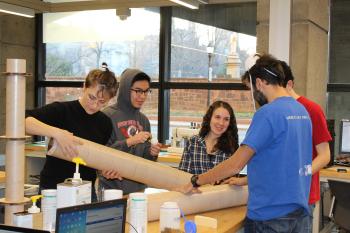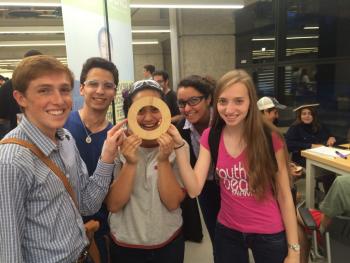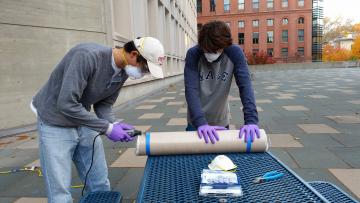From Satellites To Telescopes, The YUAA Picks Up Speed Mid-Year

With the fall semester dedicated to designing and prototyping its various projects, the Yale Undergraduate Aerospace Association (YUAA) plans to spend spring bringing its ambitious agenda for the year into execution. And with more than 60 members – the most ever for the club - good progress is being made on all fronts.
 We checked in with Pratik Gandhi, YUAA's public relations director, for a roundup of ongoing projects and about what to expect from the club in the spring semester.
We checked in with Pratik Gandhi, YUAA's public relations director, for a roundup of ongoing projects and about what to expect from the club in the spring semester.
Earth Images From a Satellite
One of the club's teams is working on a small satellite, known as a CubeSat. When complete, it will be two small cubes stacked on top of each other.
"It's going to be the first time we've put a satellite into lower orbit," said Gandhi, adding that the completed satellite will be two small cubes stacked on top of each other. "It's a multi-year project, and we have an estimated launch date somewhere in 2017."
The students working on it have split into subgroups, each specializing in different components, such as the satellite's mechanical design and computer system. Gandhi said the plan is to have a small computer on board so that the satellite can communicate and process information as it collects data. The CubeSat will take high-resolution photos of Earth from space, hopefully including some of Yale. Another possibility is that the team will use the satellite to contribute to meteorological observations. Gandhi said the club will likely use one of NASA's facilities in Florida to launch the CubeSat.
 "The secondary objective of the CubeSat is using laser communication to beam the photos back to Earth instead of using standard radio," Gandhi said. Lasers are more energy-efficient and, if successful, the system will be able to send back more volumes of data.
"The secondary objective of the CubeSat is using laser communication to beam the photos back to Earth instead of using standard radio," Gandhi said. Lasers are more energy-efficient and, if successful, the system will be able to send back more volumes of data.
Preparing for Launch
The club's rocket-building team is preparing for a return to the Intercollegiate Rocket Engineering Competition (IREC) this June in Utah. The goal this year is to build a rocket that collects air samples during its flight. The samples will be analyzed for the presence of microorganisms and used to study how organisms grow in the particular conditions of the atmosphere.
"They're almost ready - the structural design is complete and they've placed the order for the motor," Gandhi said. "The first objective is to get the rocket made, so they can at least test-fire the rocket once."
Images of Deep Space
Another team is building a computer-controlled optical telescope team outfitted with a high-resolution camera to capture images of deep space. They've built a prototype with a six-inch mirror; the final telescope will feature a mirror 12 inches in diameter.
"They want to start working on the big one as soon as we get back from the break, so that we have enough time conduct observations before the school year ends," Gandhi said
A Self-Assessing UAV
Another major project this year is the design of a high-performance unmanned aerial vehicle (UAV). The team spent the fall semester prototyping after it decided on a blended wing design, in which the wings and fuselage are blended into one structure.
While in flight, the UAV will collect data on its own performance, which the team will use to analyze how well it performs compared to a standard aircraft.

